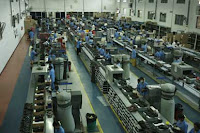 Glaze kid leather
Glaze kid leather is a light fine high-class shoe upper leather. Principle of glaze kid leather is designed depending its. Like, full in substance, tine, smooth, lightly, glossy soft to feel, resilient, and non-stretchy etc, and also from, its physical quality requirements. On the whole its principle can be summarized in the following way.
Goat skin has length 70-90 cm without any defect and disease may be chosen for glaze kid leather. Soaking is done in as usual manner, prolonged soaking is avoided as far as possible, because it may loose hide substance though, and bacteria attack.
Liming is sharp and not very prolonged. Unhairing by painting is usually done because it keeps the goat hair unaffected, which is an important by product of glaze kid leather. After painting pelts are also impedes in flesh lime liquor with certain quality of sharpening agent. After liming, sharp declining and bedding is done. After deliming and bating pelts should be flaccid, silky grain, clean and should lie in any position in which it is kept.
Cr – attaining can be done following both single and double bath process, but best known process according to the practice of Dr.belaveky’s is the skins are treated with chrome alum and dichromate in the same bath to which, after some time, hypo and acid are added. Liquor of anning should not mask.
Neutralization should done with mild alkalis and pH should be near scout 4.8. it will be better if we can avoid neutralizing syntax. Retaining is carried out in a way that there in no surface deposition.
Direct dyes have been found to have good affinity for chrome leather, acid dyes are also need. Basic dye is used to increase brilliancy in the toping. It must note contain any kind fat or oils to its surface and fat contain should not exceed 6-8%. Mainly used synthetic and semi-synthetic fat because sulphited fats are highly penetrative and make leather too soft and natural bats have very poor fixing power. So may come out on pressure. Finishing is very vital in glaze kid leather. It is essential to use smallest possible quality of pigment finish to preserve the natural grain of goatskins and to impart smooth and soft feel. It should be resistant to dry and wet rubbing and also key test should not break the finish film until the it is cracked by key test, in season coats, now-a days caseins based water pigment finishes employed, smooth grain. Top coat, protein binders, poly amide etc, used. Fixing is done by HCHO.
Protein binder has very good effect upon glaze kid leather. It can cover most of the type of defect of the grain. Protein are insoluble in water but soluble in organic solvent and are opaque. Protein has very low binding effect. So it need to mix with wax emulsion and polyurethane impart good gloss on the leather. But if there were some resin it will destroy the protein binder capacity. After completing various type of testing it is found the finished glace kid leather has made in fine quality and in Bangladesh we can make glace kid leather which will not be expensive for us and it will not take more money to produce high quality glazed kid leather as export quality.
 Safety compliance is the totality of rules, regulation operating in a working place of which an employer and an employee are bound to obey; some of them are either mandatory or directory. The notion of safety compliance is to ensure the security of life of a worker, to keep environment workable and to prefect the environment from pollution.
Safety compliance is the totality of rules, regulation operating in a working place of which an employer and an employee are bound to obey; some of them are either mandatory or directory. The notion of safety compliance is to ensure the security of life of a worker, to keep environment workable and to prefect the environment from pollution.








































